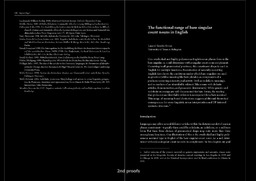
ATTENTION: The works hosted here are being migrated to a new repository that will consolidate resources, improve discoverability, and better show UTA's research impact on the global community. We will update authors as the migration progresses. Please see MavMatrix for more information.
Show simple item record
| dc.contributor.author | Stvan, Laurel Smith | |
| dc.date.accessioned | 2022-12-13T16:41:52Z | |
| dc.date.available | 2022-12-13T16:41:52Z | |
| dc.date.issued | 2007 | |
| dc.identifier.citation | Stvan, Laurel Smith. (2007). "The Functional Range of Bare Singular Count Nouns in English." In Nominal Determination: Typology, Context Constraints, and Historical Emergence (Studies in Language Companion Series 89), Elisabeth Stark, Elisabeth Leiss, and Werner Abraham, (eds.). Amsterdam: John Benjamins. Pp. 171-187. | en_US |
| dc.identifier.uri | http://hdl.handle.net/10106/31008 | |
| dc.description.abstract | **Please note that the full text is embargoed** ABSTRACT: One overlooked and highly polysemous English noun phrase form is the bare singular, i.e. a null determiner with a singular count noun complement. Occurring in all grammatical positions, this constituent shape is used in English for multiple functions. Examination of naturally occurring English data shows the conditions under which bare singulars are used as generics (with a meaning like bare plurals), as components of a predicate conveying a stereotypical activity (with an indefinite meaning), and as markers of an identifiable referent (like nouns with definite articles, demonstratives, and possessive determiners). While generic and indefinite meanings are well documented for bare forms, the reading that picks out an identifiable referent is unexpected for a bare nominal. This range of meaning-based distinctions suggests additional theoretical consequences for cross-linguistic noun interpretation and DP-internal syntactic structure. | en_US |
| dc.language.iso | en_US | en_US |
| dc.publisher | John Benjamins | en_US |
| dc.subject | bare nouns, NPs, DPs, determination | en_US |
| dc.subject | bare nouns, NPs, DPs, determination | en_US |
| dc.title | The functional range of bare singular count nouns in English | en_US |
| dc.type | Book chapter | en_US |
Files in this item
- Name:
- Stvan 2007 Functional.pdf
- Size:
- 339.0Kb
- Format:
- PDF
- Description:
- Stvan chapter from Nominal ...
This item appears in the following Collection(s)
Show simple item record


